Sorted by date Results 76 - 100 of 147
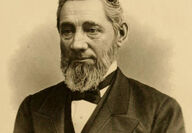
After Alaska became part of the United States in 1867, the U.S. military ruled America's newest possession for about 17 years. Then on July 4, 1884, U.S. President Chester A. Arthur appointed Republican John Henry Kinkead of Nevada as the District of Alaska's first governor. And Kinkead has the distinction of serving as the district's governor for the shortest amount of time – less than a year – as he resigned in May 1885. Kinkead, who served as Nevada's governor from 1879 to 1883, knew qui...
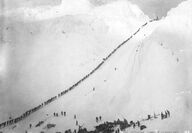
Klondike Mike Mahoney's return trip to Dawson in 1898 included a hike up the Chilkoot Trail with an unusual item strapped to his back: a piano. It all started when Mahoney hopped aboard the City of Seattle and found it stuffed to the bulwark with passengers, freight and a variety of animals, including more than 100 dogs headed to Skagway on consignment and horses crowed into stalls in the dining room. Mahoney shared his stateroom with a strange little man named Hal Henry, booking agent and manag...
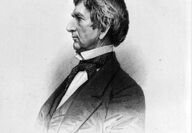
In July 1869, the steamer Active arrived in Sitka with former Secretary of State William H. Seward and his entourage on board. He had negotiated the purchase of Alaska from the Russians for a mere $7.2 million in March 1867 and now wanted to see the magnificent land for himself. U.S. Gen. Davis held events in his honor, and then Seward traveled to Lynn Canal where villagers at Klukwan gave him the honor of calling him "The Great Tyee" (chief). Seward was impressed with the ceremonial art he saw...
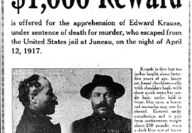
Between 1912 and 1915, a number of single, unattached men mysteriously disappeared in Southeast Alaska. The few law enforcement officials in the territory were baffled, but a suspect finally emerged in the fall of 1915. A Petersburg man named Edward Krause, who'd run for the Territorial Legislature as a Socialist Party candidate in 1912, represented himself as a U.S. Marshall to officials at the Treadwell Mine in Douglas in mid-September. Krause told the bosses that he had a court summons for...

One man who arrived in Southeast Alaska's new gold-rush settlement of Harrisburg, later named Juneau, in 1880 created a sensation by claiming he had seen a city appear above a glacier. But people who knew him said, "He was the kind of person to gaze into a raincloud and see the sun." Richard "Dick" Willoughby landed in Harrisburg from Missouri shortly after Auk chief Kowee led Joe Juneau and Richard Harris to Silver Bow Basin, which started Alaska's first big gold rush. Many historians claim the...

Russians knew there were gold deposits in Alaska, as they had sent a mining engineer to search the land after the gold discovery in the late 1840s in California. The engineer found colors all around the mouth of the Kenai River, but his discoveries must not have meant much to his superiors, because they pulled him off gold duty in 1852 and told him to look for coal instead. And the Russians didn't broadcast the fact that they had found gold, either, because they feared a rush of gold-seeking...
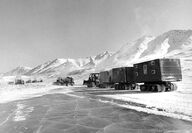
President Richard Nixon signed the Trans-Alaska Pipeline Authorization Act on Nov. 16, 1973, but many people had been working for years to lay the foundation for building that line long before it was approved. Throughout the 1960s, experts believed that the North Slope held commercially viable amounts of oil. And when found, they also knew that getting it to market would be a challenge as there was no road to Alaska's north country. The only way into the North Slope was by air or sea. The oil in...

After news of gold found in the Klondike spread during the summer of 1897, many people in the Lower 48 left their jobs and families to head north to search for their fortunes. And soon a hoax, perpetuated by promoters looking to profit off of the stampede, would eventually birth one of Alaska's most picturesque little towns. 1897-1898 headlines rang out with "Gold in Alaska. Valdez Trail – Best Trail!" But the reported pre-existing trail turned out to be a glacier that was twice as long and s...
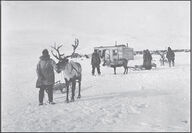
U.S. Revenue Cutter Service captains saw a need for supplemental food for Alaska's Native people in the Last Frontier during the late 1880s, as whale and seal populations had diminished. And since marine mammals were among the Natives' primary food sources, the captains became concerned for the well being of Natives living in Bering Sea villages. Capt. Michael A. Healy remembered seeing something in 1881 that might answer the problem of sustaining Alaska's Native people. While serving as...

Water in the Chena River inched up ever higher during July 1967 when 3.34 inches of rain, instead of the normal 1.84 inches, fell on Fairbanks. The city's 30,000 residents weren't too worried, though. Most were in the midst of the Alaska Purchase Centennial, celebrating the U.S. purchase of Alaska from Russia in 1867. But when 6 inches of rain fell during a period of five days, the river did crest. And on the evening of August 14, it spilled over its banks at 18.6 feet. The massive amount of wat...

During July 1791, Alexander Baranof arrived at Kodiak Island to manage the fur exporting operation of Grigorri Ivanovich Shelikhov, who formed the North American Company. When he received orders to build a sea-going vessel, Baranof remembered a sheltered bay he had seen that was a welcome refuge from Pacific storms. Baranof had named it Resurrection Bay, where Seward now exists, as he had found it during the Easter season. Baranof knew he would have access to timber suitable for shipbuilding,...

Among the memorials in the Anchorage Municipal Park Cemetery stands a small, pink marker adorned with a palette. It is the final resting place of Sydney Mortimer Laurence, one of Alaska's greatest artists, who died in 1940. Known for his dramatic landscape paintings, Laurence was one of the first professionally trained artists to live in Alaska. His works, which often featured Denali, hang in the Musee du Louvre in Paris, the National Art Gallery in Washington, D.C., and many other locations aro...

One northern town became an integral part of Alaska's gold rush history after prospectors sifting through red rocks along a creek south of the Yukon River thought they had found rubies mixed with gold nuggets. They named the new prospect Ruby Creek, although the red rocks turned out to be garnets. The discovery of large quantities of gold in the creek in 1906 brought even more stampeders into Alaska's Interior. And when word leaked out in 1910 that more gold had been found on Long Creek, about...
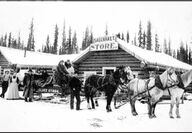
Imagine being deemed insane through a jury trial, and then sent to the Lower 48 for treatment in the dead of winter before planes and automobiles were available to transport you south. That's what happened to some Alaskans at the turn of the last century. The opening of the Alaska Psychiatric Institute in Anchorage in 1962 marked a dramatic change in the way Alaska handled those who suffered from mental illness. Construction of the facility meant Alaskans might find treatment for their mental...

There was no border established between the Great Land and Canada when the U.S. agreed to purchase Alaska from Russia for 2 cents an acre in March 1867. The lack of an agreed-upon boundary caused problems from the get-go. Russian maps of the time showed more land belonging to them than was stipulated in an 1825 treaty between Russia and Great Britain. That treaty divided the Northwest American territories between the Hudson's Bay Company and the Russian-American Company trading areas and...

In the mid 1930s, a few fellows got together and decided it would be great to put together a winter sports tournament for all of Anchorage's residents. Vern Johnson, Clyde Conover, Thomas Bevers and Dale Bowen wanted to organize several teams to compete in hockey and basketball. With the city's population less than 4,000 at the time, the idea took hold and turned into a carnival to show community support and celebrate the beginning of the end of winter. Revelers bought tickets to the Winter...

Juneau became the capital of the 49th state on Jan. 3, 1959, after U.S. President Dwight D. Eisenhower signed the statehood act into law. It became the only state capital not accessible by road. But Juneau was not the capital of the Last Frontier when Alaska became part of the United States in 1867. Sitka was the center of government for Russia-America. So why did the Americans choose to move government offices to Juneau? The discovery of gold deposits in the area that became Juneau-Douglas in...
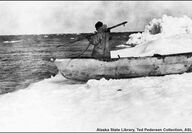
More than four decades ago Congress enacted the Alaska Native Land Claims Settlement Act, which conveyed about 40 million acres to Alaska Native-owned corporations and settled aboriginal land claims. President Richard M. Nixon signed it into law in December 1971. Why was the Native land claims such a big issue after statehood? The Alaska Statehood Act said the new state could choose more than 103 million acres of its land – an amount larger in total area than California – to build its eco...

Homer residents turned to Betty Crocker when they needed a firetruck in the late 1960s after learning about a promotion offered by General Mills. The nationally known company offered a program where people could turn in their coupons for large househlold items. An $800 piano could be purchased with 160,000 coupons redeemed at one-half penny each, according to a Homer Tribune article, titled "Bringing home 'Betty," by Naomi Klouda. How many coupons did it take to get a fire truck? Five million,...

Four small cannons in Sitka, which started out in Unalaska, stand in testimony to Alaska's occupation by Russia and the subsequent transfer of Alaska to America 150 years ago. The Northern Commercial Company in Unalaska donated the cannons to the state of Alaska two years after statehood. The artifacts date back to the 1700s, when Lord Baranof ruled Alaska for Russia as its manager and governor. The antique guns, made of bronze, weighed about 500 pounds each and had the date 1723 stamped on...

Enterprising newsmen published the first issue of the Yukon Press in March 1898. The 14-page effort shared the news of the day from St. Michael to the upper Yukon. With the discovery of gold along Interior rivers and in the Klondike region, thousands of stampeders flooded into the wilderness of Alaska looking for their pot of gold. Circle City, located about 160 miles northeast of present-day Fairbanks, got its start in 1894 as the supply center for the Circle Mining District 50 miles to the...

A pachyderm named Annabelle, who became prolific with a paintbrush and easel, is responsible for the creation of the Alaska Zoo in Anchorage. It all started when Jack Snyder saw a tongue-in-cheek come-on for a Chiffon toilet paper contest for grocers in 1966. The Crown Zellerbach company ad announced: "$3,000 or a baby elephant" to the winner. The Anchorage grocer won the contest. Snyder then startled the tissue paper executives when he said, "I'll take the elephant." One can just imaging the...

Baseball has long been a staple of summers in Alaska. And when Anchorage baseball fans wanted a semi-pro team in 1969, they knew they could count on George "Lefty" Van Brunt to coach the boys of summer from the first base side of the plate. Lefty's career with the Anchorage Glacier Pilots began that year when the Anchorage Community got serious about baseball because the adult league's all-star team could never beat the Fairbanks team. "The Gold Panners used to come down and kick our butts,"...
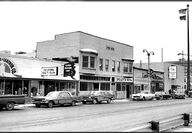
A small spruce that peered skyward in a dense forest on Prince of Wales Island in the mid-1700s found its way to Anchorage when Alaska became America's 49th state. This Southeast Alaska sapling held no importance when Secretary of State William Seward finalized the purchase of Alaska from the Russians on March 30, 1867. And most Americans at the time thought Alaska unimportant, as well, and referred to it as "Seward's Ice Box." But just as Alaska grew in importance for the nation, this little...

While the Southeast town of Sitka claims the first U.S. Post Office established in America's new possession of Alaska in 1867, Circle City – located on the banks of the Yukon River – holds the honor for the first post office in Alaska's Interior, according to "Directory of Alaska Post Offices and Postmasters." Circle City's first postmaster, famous outfitter Jack McQuesten, was appointed on March 19, 1896. Mail had been carried by private mail runners that traveled along a route from the new...